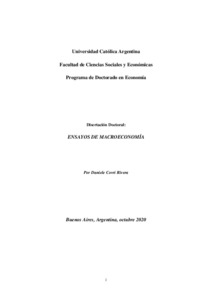Por favor, use este identificador para citar o enlazar este ítem:
https://repositorio.uca.edu.ar/handle/123456789/15384| Título: | Ensayos de macroeconomía | Autor: | Covri Rivera, Daniele | Otros colaboradores: | Trupkin, Danilo R. Garegnani, María Lorena Elosegui, Pedro |
Director de Tesis: | García Cicco, Javier | Palabras clave: | CURVA DE PHILLIPS; VARIABLES INSTRUMENTALES; MACROECONOMÍA; POLITICA ECONOMICA; EMPLEO; INFLACION; DOLAR; POLITICA MONETARIA | Fecha de publicación: | 2020 | Cita: | Covri Rivera, D. Ensayos de macroeconomía [en línea]. Tesis doctoral. Pontificia Universidad Católica Argentina, 2020. Disponible en: https://repositorio.uca.edu.ar/handle/123456789/15384 | Resumen: | Resumen: Este trabajo de análisis consiste en aplicar la curva de Phillips para Ecuador en el
periodo de la dolarización. Los datos fueron ajustados por un quiebre estructural presente
al principio de la muestra y abarcan un horizonte temporal que va desde el primer
trimestre 2003 hasta el cuarto trimestre 2015. Se contextualizaron las variables a la
realidad ecuatoriana, pero el núcleo central está constituido por la estimación
econométrica. La primera parte prevé regresiones MCO con expectativas adaptativas, y
las brechas del desempleo y del producto fueron obtenidas mediante un filtro de Hodrick
y Prescott. Después se repitió el proceso mediante variables instrumentales con
expectativas racionales y al final se estimaron también tres modelos DSGE
neokeynesianos. Se encontró que la curva de Phillips se valida únicamente con la brecha
del desempleo, mientras que las expectativas de inflación resultan significativas
únicamente en los modelos multiecuacionales que involucran la brecha del producto. En
conclusión, políticas que quieran estimular el empleo tienen un efecto de alza en los
precios, por lo que la situación puede justificarse en periodos recesivos para evitar una
eventual deflación. Abstract: This paper consists of applying the Phillips curve for Ecuador in the period of dollarization. The data were adjusted for a structural break present at the beginning of the sample and cover a time horizon that goes from the first quarter of 2003 to the fourth quarter of 2015. The variables were contextualized to the Ecuadorian reality, but the core is based on the econometric estimation. The first part foresees OLS regressions with adaptive expectations, and the unemployment and output gaps were obtained using a Hodrick and Prescott filter. The process was then repeated using instrumental variables with rational expectations and at the end three New Keynesian DSGE models were also estimated. It was found that the Phillips curve is validated only with the unemployment gap, while inflation expectations are significant only in the multi-equation models that involve the output gap. In conclusion, policies that want to stimulate employment have a rising effect on prices, so this policy can be justified in recessive periods to avoid a possible deflation. |
Cobertura Espacial: | Ecuador | Cobertura Temporal: | Siglo XXI | URI: | https://repositorio.uca.edu.ar/handle/123456789/15384 | Disciplina: | ECONOMIA | Derechos: | Acceso abierto | Fuente: | Tesis doctoral. Pontificia Universidad Católica Argentina, 2020 |
| Aparece en las colecciones: | Tesis de Doctorado en Economía |
Ficheros en este ítem:
| Fichero | Descripción | Tamaño | Formato | |
|---|---|---|---|---|
| ensayos-macroeconomia.pdf | 2,39 MB | Adobe PDF |  Visualizar/Abrir |
Visualizaciones de página(s)
451
comprobado en 27-abr-2024
Descarga(s)
7.441
comprobado en 27-abr-2024
Google ScholarTM
Ver en Google Scholar
Este ítem está sujeto a una Licencia Creative Commons

